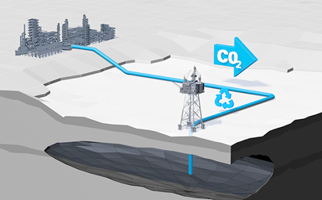The North Sea is increasingly crowded – but there is room for everyone
- Collaboration and co-ordination are key to sharing limited space
- Technology is developing to meet the needs of all users
- Freely-available data vital to slotting the pieces together
A combination of collaboration, exciting new technology and access to an abundance of freely-available data will enable harmonious sharing of space on the North Sea, NSTA Director of New Ventures Andy Brooks said today.
Speaking at the All-Energy Conference in Glasgow, Mr Brooks told attendees that although offshore space is increasingly busy, co-location of different energy technologies is entirely possible and the NSTA is working with others to drive a co-ordinated approach to managing the seabed.
Brooks, speaking as the NSTA announced the launch of a call for nominations for new areas for prospective carbon storage licensing, went on to say: “Different energy activities can co-locate and co-exist offshore, with spatial overlaps managed through early engagement and co-ordination, careful sequencing of activities, and deployment of specific technology.
“We are already doing this. Through our engagement with bodies such as The Crown Estate and Crown Estate Scotland, existing spatial overlaps are being managed. This engagement needs to be started early by sharing potential issues and data so that overlaps are minimised where possible but can ultimately be managed successfully.
“Windfarm leases and oil and gas licences are already co-locating in several places, in particular in the Southern North Sea.”
Brooks cited the examples of how co-ordination between operators has enabled the successful co-existence of the Dudgeon windfarm, which overlaps with the Blythe and Elgood fields, and the Walney Extension and Rhyl gas field, operating side-by-side in the Irish Sea.
He then tackled the long-held belief that while it is possible to get oil and gas to work in parallel with wind farms, carbon storage is a step too far.
He said: “Opinions on that have started to mellow. Technology in this field has advanced greatly and can be the answer to the problems we need to overcome.
“For example, companies such as Fugro and Oceaneering offer unmanned surface vessels which carry out underwater inspections, taking up less room between turbines and oil and gas platforms, in addition to having lower emissions than manned vessels.
“CCS measuring, monitoring and verification technology is now becoming standard in many operators’ technology plans, and piloted in the recent appraisal well test by Perenco in the UK Southern North Sea.
“Fibre optic sensing avoids the need for vessels to sail amongst offshore installations to shoot seismic data and the seismic data originally shot to locate oil and gas is now being used to identify sites for CCS.”
Brooks went on to reference the important role data and AI will play as the energy transition continues.
He said: “The NSTA’s UK National Data Repository contains an abundance of this and other free information, dating back 60 years, which has been used for numerous world-leading academic research studies.
“And AI will play a crucial role as well, helping industry solve complex planning challenges.”
And he concluded with a positive message about the future role of the North Sea.
“The energy industry has proven over the decades its ability to solve seemingly impossible problems,” he said.
“(We) require industry and regulatory coordination, transparency and a willingness to come together to resolve the problems we must overcome to help achieve our net zero goals and, it will be the people within our industries today that will ultimately find the solutions needed.”
Notes to editors:
Read the full speech here
For further information please contact:
Tel: 07785 655620


